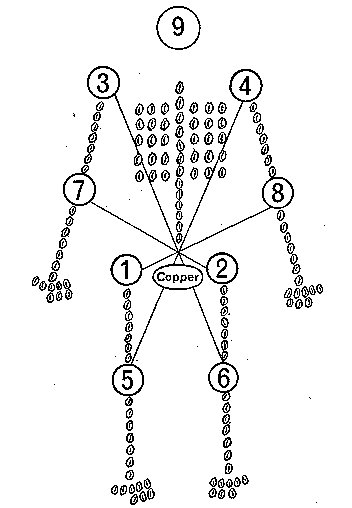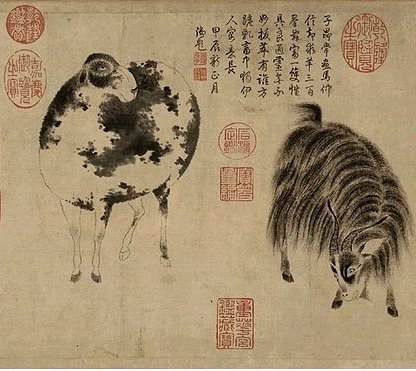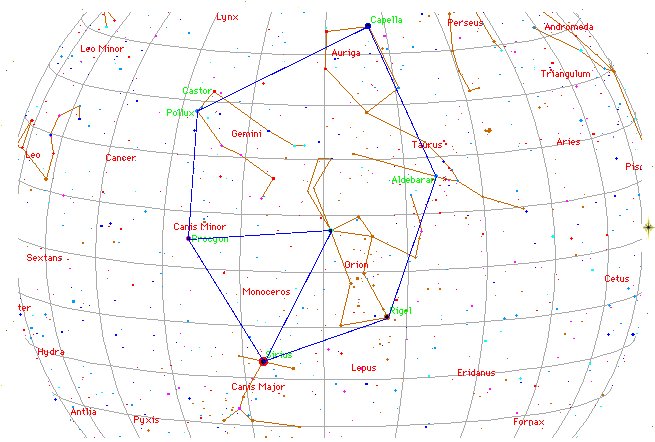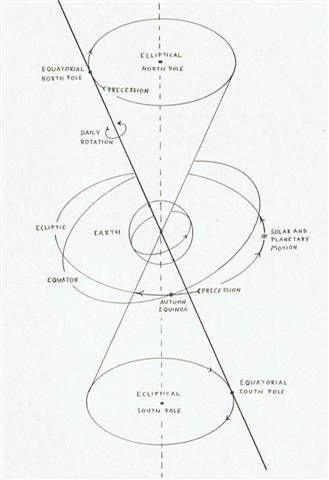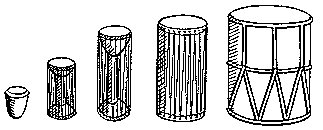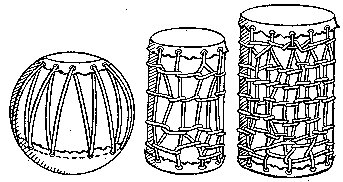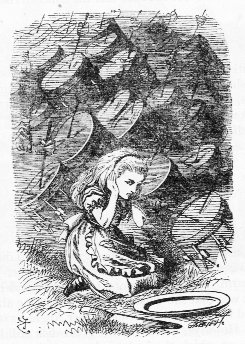291. The first places named by Makoi were 8 in number - because it was Ira who had pointed out the first 3 islets: ... He ui a Ira.ko te motu etoru.he ki a Ira.he ro korua e kau a repa e ku ketu ana te urunga.a Hau maka o to tatou matua.i hakahi mai ai kia au.ko nga kope ririva tutuu vai a te taanga.te ingoa o te motu ena etoru i nape ai e te kuhane o Hau maka. Ira saw that there were three such islets. Ira said, 'Hey you, crew of young men, the vision of Hau Maka, our father, which he revealed to me, has come true. There are 'the handsome sons of Te Taanga, who are standing in the water', for this is the name that the dream soul of Hau Maka gave them. (E:17)
Possibly the time of midnight (a Janus point) should be illustrated with a pair of glyphs. However, Castor at 113.4 - 41.4 = *72.0 would have risen with the Sun around 6 a.m. in July 12 (193 = 152 + 41) with ¼ of him belonging in day 194. I.e. day *73 at the time of Bharani corresponded to how March 14 (3-14 →π) was day 73 counted from January 1. 73 + 80 = 153 = 194 - 41. Which means the ihe tau glyph
could represent the last quarter of the day of Castor as measured (at the time of rongorongo) for the (true heliacal) time of sunrise. Notably the Arabs had in their structure primarily chosen heliacal stars with the fraction 41.4 - 41 = 0.4 (= 12 * 12 / 360).
The Julian equinox (*84) was perhaps a kind of Janus point. ... Ogotemmêli had his own ideas about calculation. The Dogon in fact did use the decimal system, because from the beginning they had counted on their fingers, but the basis of their reckoning had been the number eight and this number recurred in what they called in French la centaine, which for them meant eighty. Eighty was the limit of reckoning, after which a new series began. Nowadays there could be ten such series, so that the European 1,000 corresponded to the Dogon 800. But Ogotemmêli believed that in the beginning men counted by eights - the number of cowries on each hand, that they had used their ten fingers to arrive at eighty, but that the number eight appeared again in order to produce 640 (8 x 10 x 8). 'Six hundred and forty', he said, 'is the end of the reckoning.' According to him, 640 covenant-stones had been thrown up by the seventh Nummo to make the outline in the grave of Lébé ...
There was a single head and then there were 8 joints for working hard down on the earth. ... During his descent the ancestor still possessed the quality of a water spirit, and his body, though preserving its human appearance, owing to its being that of a regenerated man, was equipped with four flexible limbs like serpents after the pattern of the arms of the Great Nummo. The ground was rapidly approaching. The ancestor was still standing, his arms in front of him and the hammer and anvil hanging across his limbs. The shock of his final impact on the earth when he came to the end of the rainbow, scattered in a cloud of dust the animals, vegetables and men disposed on the steps. When calm was restored, the smith was still on the roof, standing erect facing towards the north, his tools still in the same position. But in the shock of landing the hammer and the anvil had broken his arms and legs at the level of elbows and knees, which he did not have before. He thus acquired the joints proper to the new human form, which was to spread over the earth and to devote itself to toil ... Anciently the whole seems to have been One and 8. But according to the Mayas the whole was One and 7 Hunaphu: ... The father does not disappear, but goes on being fulfilled. Neither dimmed nor destroyed is the face of a lord, a warrior, craftsman, an orator. Rather, he will leave his daughters and sons. So it is that I have done likewise through you. Now go up there on the face of the earth; you will not die. Keep the word. So be it, said the head of One and Seven Hunaphu - they were of one mind when they did it ... 360 / 8 = 45 and 350 / 7 = 50. Counted from zero at Hyadum II the hairy twin who died (Castor, Enkidu etc) was in day 50: ... it is told that he [Gilgamesh] lives in splendor and dissoluteness, and makes a nuisance of himself until the gods bring relief to his people by rearing a human being, either twin or counterpart,³ who can stand up to him. It is Enkidu, the man of the Wilds, a kind of wolf-child as simple as the beasts he plays with, a happy son of nature, hairy all over, grown to enormous strength ... ³ Actually, the goddess Aruru makes him 'in the likeness of Anu', literally 'a zikru of Anu she conceived in her heart'. But Enkidu is also said to look like Gilgamesh 'to a hair' ...
... Ishtar appears on the walls of Uruk and curses the two heroes who have shamed her, but Enkidu tears out the right thigh of the Bull of Heaven and flings it in her face, amidst brutal taunts. It seems to be part of established procedure in those circles. Susanowo did the same to the sun-goddess Amaterasu, and so did Odin the Wild Hunter to the man who stymied him. A scene of popular triumph and rejoicings follows. But the gods have decided that Enkidu must die, and he is warned by a somber dream after he falls sick ...
And close to the Full Moon was the Arrow, possibly the One released from the Golden Bough (or Bow):
... To conclude these enquiries we may say that if Balder was indeed, as I have conjectured, a personification of a mistletoe-bearing oak, his death by a blow of the mistletoe might on the new theory be explained as a death by a stroke of lightning. So long as the mistletoe, in which the flame of the lightning smouldered, was suffered to remain among the boughs, so long no harm could befall the good and kindly god of the oak, who kept his life stowed away for safety between earth and heaven in the mysterious parasite; but when once that seat of his life, or of his death, was torn from the branch and hurled at the trunk, the tree fell - the god died - smitten by a thunderbolt. And what we have said of Balder in the oak forests of Scandinavia may perhaps, with all due diffidence in a question so obscure and uncertain, be applied to the priest of Diana, the King of the Wood, at Aricia in the oak forests of Italy. He may have personated in flesh and blood the great Italian god of the sky, Jupiter, who had kindly come down from heaven in the lightning flash to dwell among men in the mistletoe - the thunder-besom - the Golden Bough - growing on the sacred oak in the dells of Nemi. If that was so, we need not wonder that the priest guarded with drawn sword the mystic bough which contained the god's life and his own. The goddess whom he served and married was herself, if I am right, no other than the Queen of Heaven, the true wife of the sky-god. For she, too, loved the solitude of the woods and the lonely hills, and sailing overhead on clear nights in the likeness of the silver moon looked down with pleasure on her own fair image reflected on the calm, the burnished surface of the lake, Diana's Mirror ... The armpit of Orion was in the center of the winter hexagon, with Castor outside: ... The most important of all drums, he said, was the armpit drum. The Nummo made it. It consists of two hemispherical wooden cups connected through their centres by a slender cylinder. It is like an hour-glass with a very long narrow neck. With this instrument tucked between his left arm and armpit, the drummer, by pressing on the hollow structure of thin wood, can tighten or relax the tension on the skins and so modify the tone. 'The Nummo made it. He made a picture of it with his fingers, as children do today in games with string.' Holding his hands apart, he passed a thread ten times round each of the four fingers, but not the thumb. He thus had forty loops on each hand, making eighty threads in all, which, he pointed out, was also the number of teeth of his jaws. The palms of his hands represented the skins of the drum, and thus to play on the drum was, symbolically, to play on the hands of the Nummo ...
... Each drum had a sound of its own, and so each family had its own language, which is the reason why there are different languages today. The first two families, settled in the south, spoke two dialects of Toro, not very different from each other; the third family spoke Mendéli; the fourth spoke Sanga; the fifth another form of Toro; the sixth Bamba; and the seventh Iréli. Lastly the eighth family was given a language which is understood in all parts of the cliff. Just as the eighth drum dominates all the others, so the eighth language is understood everywhere. It was thus that men were given the third Word, final, complete and multiform to suit the new age. It was closely associated, like the first and second Words, and even more than they, with material objects. At this point an odd reflection occured to the European. The first imperfect Word was associated with a technical process, simple in character and no doubt the most archaic of all processes, which had produced the most primitive form of clothing made of fibre. The fibre, which was neither knotted nor woven, flowed in a wavy line, and might be said therefore to be of one dimension. The second Word, less restricted than the first, arose from weaving, done on a wide warp crossed by vertical threads forming a surface, that is to say, having two dimensions. The third Word, clear and perfect in character, took shape in a cylinder with a strip of copper winding through it, that is to say, in a three-dimensional figure. These three technical processes (as he further remarked) all proceeded by following a line, either undulating or zig-zag, and each was characterized by three distinct features: humidity of the fibres, ensuring the freshness necessary for procreation; light for the weaving, that being a daylight process, prohibited at night on pain of blindness; sonority of the drum. There was also a development, from the material point of view, from trimmed bark to cotton thread, and from thread to leather strips and to a copper band ...
|
|||||||||||||||||||||||||||||||||||||||||||||||||||||||||||||||||||||||||||||||||||||||||||||||||||||||||||||||||||||||||||||||||||||||||||||||||||||||||||||||||||||||||||||||||||||||||||||||||||||||||||||||||||||||||||||||||||||||||||||||



